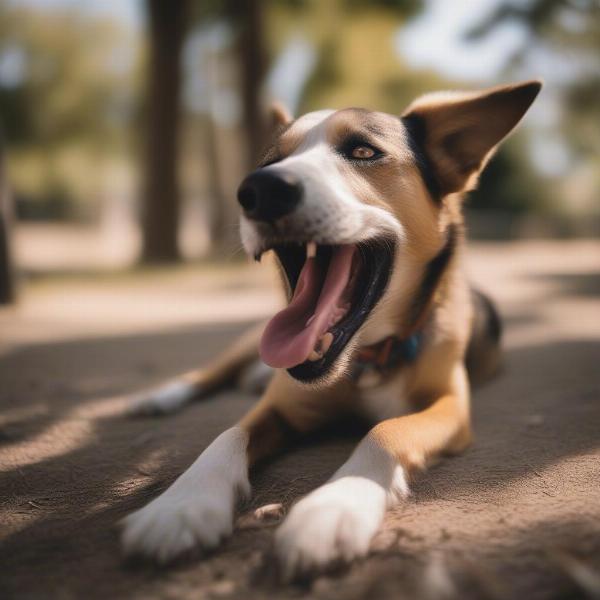Dog pacing and panting are common behaviors, but they can sometimes signal underlying issues. Understanding why your dog is exhibiting these behaviors is crucial for ensuring their well-being. This article will delve into the various reasons behind dog pacing and panting, helping you differentiate between normal and problematic instances, and providing guidance on when to seek veterinary care.
Common Causes of Dog Pacing and Panting
Several factors can contribute to pacing and panting in dogs. It’s essential to consider the context of the behavior to determine the cause.
Excitement or Anticipation
One of the most common reasons for pacing and panting is simple excitement. Perhaps you’re preparing their meal, getting ready for a walk, or a beloved family member has just arrived home. This anticipation can manifest as increased activity and panting.
Heat or Overexertion
Dogs regulate their body temperature through panting. If your dog is panting heavily after exercise or on a hot day, it’s likely due to overheating. Make sure they have access to fresh water and a cool, shaded area to rest.  Dog Panting in Hot Weather
Dog Panting in Hot Weather
Anxiety or Stress
Pacing and panting can also be signs of anxiety or stress. Loud noises like fireworks or thunderstorms, changes in routine, or separation anxiety can trigger these behaviors. Identifying and addressing the source of anxiety is key to helping your dog feel more comfortable. dog anxiety bed can provide comfort in these situations.
Pain or Discomfort
If your dog is pacing and panting excessively and there’s no apparent external cause, they might be experiencing pain or discomfort. This could be due to an injury, illness, or underlying medical condition.
When to Seek Veterinary Attention
While pacing and panting can be normal, it’s crucial to recognize when these behaviors warrant a visit to the veterinarian. Consult a professional if:
- The panting is excessive or doesn’t seem related to heat or exercise.
- The pacing is persistent and accompanied by other symptoms, such as whining, restlessness, or changes in appetite.
- Your dog seems distressed or uncomfortable.
- Your dog’s gums are pale or bluish. dog is pacing and panting explains this further.
Helping Your Dog Cope with Pacing and Panting
Addressing pacing and panting requires identifying the underlying cause. If it’s excitement-related, providing a calming environment can help. If it’s due to anxiety, consider behavioral modification techniques or consulting a certified professional dog trainer. dog panting and pacing offers more detailed information on this topic. For heat-related panting, ensure your dog has access to cool water and shade. If pain or illness is suspected, immediate veterinary care is essential.
Expert Insight: Dr. Emily Carter, DVM
“Pacing and panting are non-specific symptoms, meaning they can be indicative of a wide range of issues. A thorough veterinary examination is essential to rule out any underlying medical conditions and determine the best course of action.”
Expert Insight: Sarah Miller, Certified Dog Trainer
“If anxiety is the cause of your dog’s pacing and panting, implementing a consistent training regimen and creating a predictable routine can help alleviate their stress.”
Conclusion
Understanding why your dog is pacing and panting is crucial for their well-being. By observing the context of these behaviors and seeking professional help when necessary, you can ensure your furry friend receives the appropriate care and support. Identifying the cause of dog pacing and panting allows for effective intervention and a happier, healthier canine companion.
FAQ
- Why is my dog pacing and panting at night? This could be due to anxiety, cognitive dysfunction, or pain. dog pacing and panting at night provides more information.
- Is it normal for a dog to pant after exercise? Yes, panting is a normal way for dogs to regulate their body temperature.
- When should I be concerned about my dog’s panting? If the panting is excessive, doesn’t subside with rest, or is accompanied by other symptoms, consult a veterinarian.
- Can pain cause a dog to pace and pant? Yes, pain and discomfort can lead to increased pacing and panting.
- How can I help my anxious dog stop pacing and panting? Creating a calm environment, using anxiety-reducing aids, and consulting a professional trainer can be helpful.
- What are the signs of heatstroke in dogs? Excessive panting, drooling, weakness, and collapse are signs of heatstroke, requiring immediate veterinary attention.
- Could pacing and panting be a sign of a serious illness? Yes, certain medical conditions can cause these behaviors, so it’s important to consult a vet if you’re concerned.
ILM Dog is your trusted resource for all things canine. We provide expert advice on dog breeds, health, training, nutrition, grooming, and much more. Whether you’re a seasoned dog owner or just starting your journey, ILM Dog offers valuable insights to help you provide the best possible care for your furry companion. For personalized guidance and support, contact us via email at [email protected] or by phone at +44 20-3965-8624.